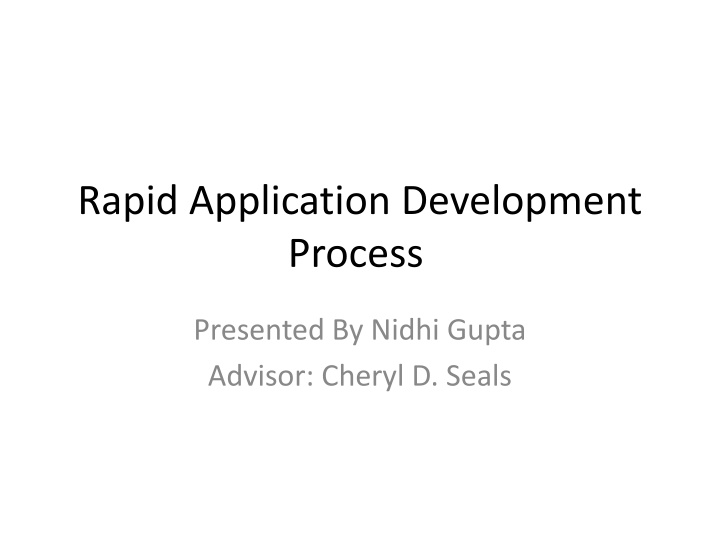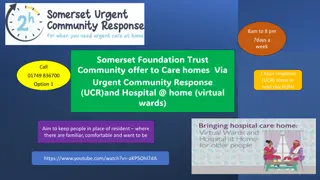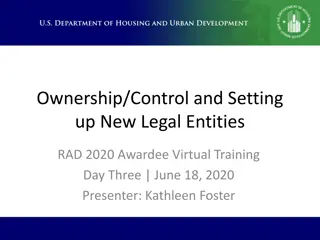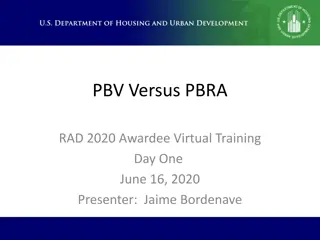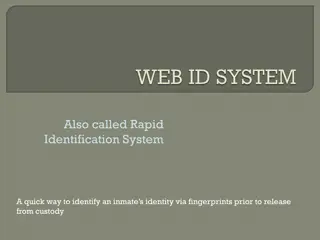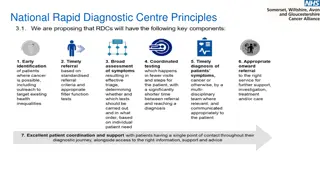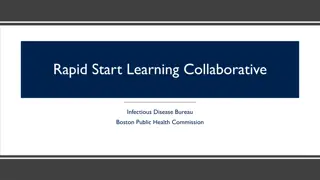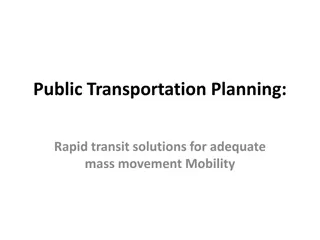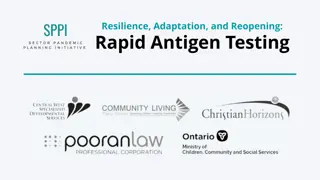Rapid Application Development (RAD) Process
Rapid Application Development (RAD) is a software development process that focuses on minimizing pre-planning and accelerating the software development lifecycle. By involving users early on, utilizing prototyping, and emphasizing user requirements, RAD aims to deliver high-quality systems quickly. This methodology contrasts traditional approaches by allowing for iterative development and user feedback throughout the process. RAD consists of key stages such as Requirements Planning, User Design, Construction, and Implementation to ensure efficient and effective delivery of software solutions.
Download Presentation

Please find below an Image/Link to download the presentation.
The content on the website is provided AS IS for your information and personal use only. It may not be sold, licensed, or shared on other websites without obtaining consent from the author.If you encounter any issues during the download, it is possible that the publisher has removed the file from their server.
You are allowed to download the files provided on this website for personal or commercial use, subject to the condition that they are used lawfully. All files are the property of their respective owners.
The content on the website is provided AS IS for your information and personal use only. It may not be sold, licensed, or shared on other websites without obtaining consent from the author.
E N D
Presentation Transcript
Rapid Application Development Process Presented By Nidhi Gupta Advisor: Cheryl D. Seals
Introduction Rapid Application Development (RAD) Process It refers to the type of Software development process, which minimizes the pre-planning phase, and results in more rapid software development lifecycle. The idea behind this methodology is to start developing as early as possible so that clients can review a working prototype and offer additional direction . RAD calls for the interactive use of structured techniques and prototyping to define user's requirements and design the final system. Using structured techniques, the developer first builds preliminary data models and business process models of the business requirements. Prototyping then helps the analyst and users to verify those requirements and to formally refine the data and process models.
Major Disadvantages Of Traditional Method Applications took so long to build that requirements got changed before the system was complete. Resulting in inadequate or even unusable systems. The main cause of the problem was identified in the strict adherence to completion of one lifecycle stage before moving on to the next lifecycle stage.
Factors influence RAD Several factors contribute to the success of rapid development process by improving both the quality of the delivered system and the speed of delivery. Use of prototyping, which helps users visualize and make adjustments to the system. User involvement in the Construction stage, allowing the details to be adjusted if necessary
Various Stages of RAD Requirements Planning The Requirements Planning stage consists of a review of the areas immediately associated with the proposed system. This review produces a broad definition of the system requirements in terms of the functions the system will support. User Design The User Design stage consists of a detailed analysis of the business activities related to the proposed system. Output of this stage are like Prototypes of critical procedures , plan for implementing the system is prepared , preliminary layouts of screens etc.
Stages of RAD Continue .. Construction In the Construction stage, a small team of developers, working directly with users, finalizes the design and builds the system. The software construction process consists of a series of "design-and-build" steps in which the users have the opportunity to fine-tune the requirements and review the resulting software implementation. Implementation The implementation stage involves implementing the new system and managing the change from the old system environment to the new one.
Core Elements of Rapid Application Development Prototyping Iterative Development Time Boxing Team Members Management Approach RAD Tools
Core Elements of Rapid Application Development Prototyping The objective is to build a feature light version of the finished product in a short an amount of time . The initial prototype serves as a proof of concept for the client, but more importantly serves as a talking point and tool for refining requirements. Iterative Development Iterative development means creating increasingly functional versions of a system in short development cycles. Each version is reviewed with the client to produce requirements that feed the next version.
Core Elements of Rapid Application Development Time Boxing Time boxing is the process of putting off features to future application versions in order to complete the current version in as short amount of time as possible. Team Members The RAD methodology recommends the use of small teams that consist of experienced, versatile, and motivated members that are able to perform multiple roles.
Core Elements of Rapid Application Development Management Approach Active and involved management is vital to mitigate the risks of lengthened development cycles, client misunderstandings, and missed deadlines. RAD Tools One of the primary objectives of the Rapid Application Development methodology was to take advantage of the latest technology available to speed development.
Advantages Of RAD Increased Speed primary advantage lies in an application's increased development speed and decreased time to delivery. Increased Quality Rapid Application Development attempts to deliver on quality through the heavy involving of users in the analysis and particularly the design stages.
Disadvantages Of RAD Reduced Scalability Because RAD focuses on development of a prototype that is iteratively developed into a full system, the delivered solution may lack the scalability of a solution that was designed as a full application from the start. Reduced Features In RAD features are pushed off to later versions in favor of delivering an application in a short time frame, therefore RAD may produce applications that are less full featured than traditionally developed applications.
Various RAD Methodologies Agile Software Development Joint Application Development (JAD) EXTREME PROGRAMMING (XP) Scrum Development Process Lean software development (LD)
Agile Software Development Introduction Agile methods break tasks into small increments with minimal planning, and do not directly involve long-term planning. Iterations are short time frames that typically last from one to four weeks. Each iteration involves a team working through a full software development cycle including planning, requirements analysis, design, coding, unit testing, and acceptance testing when a working product is demonstrated to stakeholders.
Agile Methods: Embracing Change Agile Development Methods helps minimize overall risk, and lets the project adapt to changes quickly. An iteration may not add enough functionality to warrant a market release, but the goal is to have an available release (with minimal bugs) at the end of each iteration. Multiple iterations may be required to release a product or new features. Agile heavyweight process overhead and artifacts. methods stress productivity and values over
Advantages Of Agile Development Process Revenue The iterative nature of agile development means features are delivered incrementally, enabling some benefits to be realized early as the product continues to develop. Speed-to-market Agile development philosophy also supports the notion of early and regular releases. Quality A key principle of agile development is that testing is integrated throughout the lifecycle, enabling regular inspection of the working product as it develops. This allows the product owner to make adjustments if necessary and gives the product team early sight of any quality issues.
Agile Advantages Cont.. Visibility Agile involvement throughout the product's development and a very cooperative collaborative approach, which provide excellent visibility throughout the product. Risk Management development principles encourage active 'user' Small incremental releases made visible to the product owner and product team through its development, help to identify any issues early and make it easier to respond to change.
Agile Advantages Cont.. Flexibility / Agility In agile development, change is accepted in fact, it's expected. As the timescale is fixed , the requirements emerge and evolve as the product is developed Business Engagement/Customer Satisfaction The active involvement of a user representative and/or product owner, the high visibility of the product and progress, and the flexibility to change when change is needed, creates much better business engagement and customer satisfaction.
Agile Advantages Cont.. Right Product Agile development requirements to emerge and evolve, and it has the ability to embrace change (with the appropriate trade-offs), therefore team builds the right product. More Enjoyable Cooperation and collaboration make agile development team, a much more enjoyable place for most people. Instead of big specs, the team discusses requirements in workshops. Instead of lengthy status reports, we collaborate around a task-board discussing progress. Instead of long project plans and change management committees, we discuss what's right for the product and project and the team is empowered to make decisions.
Disadvantages Of Agile Development Process Active user involvement and close collaboration are required throughout the development cycle , however these principles are very demanding on the user representative's time and require a big commitment for the duration of the project.
Disadvantages Of Agile Cont.. Requirements emerge and evolve throughout the development (flexibility). Due to flexibility, there is much less predictability, at the start of the project and during, about what the project is actually going to deliver. This can make it harder to define a business case for the project, and harder to negotiate fixed price projects.
Joint Application development Process Introduction JAD (Joint Application Development) is a methodology that involves the client or end user in the design and development of an application, through collaborative workshops called JAD sessions. JAD is a process used in the Systems Development Life Cycle (SDLC) to collect business requirements while developing new information systems for a company. a succession of
JAD Sessions The attendees include high level management officials who will ensure the product provides the needed reports and information at the end. Through JAD workshops workers and IT specialists are able to resolve any difficulties or differences between the two parties regarding the new information system. the knowledge
Key Participants for JAD Session Executive Sponsor Project : system owner Leader/Manager : leader of the application development team Facilitator/Session Leader: Chairs the meeting and directs traffic by keeping the group on the meeting agenda Scribe/Modeller/Recorder/Documentation Expert: Records and publish the proceedings of the meeting Participants: Customers in the business area directly or indirectly being affected by this project(experts in their field). Observers: Generally members of the application development team assigned to the project
Steps in Performing JAD Identify project objectives and limitations, it is vital to have clear objectives for the workshop and for the project as a whole. Identify critical success factors, It is important to identify the critical success factors for both the development project and the business function being studied. Like How will we know that the planned changes have been effective? How will success be measured?
Steps in Performing JAD Cont.. Define project deliverables, the deliverables from a workshop are documentation and a design. It is important to define the form and level of detail of the workshop documentation. What types of diagrams will be provided? What type or form of narrative will be supplied? Define the schedule of workshop activities. Workshops vary in length from one to five days. The initial workshop for a project should not be less than three days.
Steps in Performing JAD Cont.. Select the participants these are the business users, These are the business users, the IS professionals, and the outside experts that will be needed for a successful workshop. These are the true "back bones" of the meeting who will drive the changes. Prepare the workshop material before the workshop, Before the workshop, the project manager and the facilitator perform an analysis and build a preliminary design or straw man to focus the workshop.
Steps in Performing JAD Cont.. Organize workshop activities and exercises, The facilitator must design workshop exercises and activities to provide interim deliverables that build towards the final output of the workshop. Prepare, inform, and educate the workshop participants, All of the participants in the workshop must be made aware of the objectives and limitations of the project and the expected deliverables of the workshop. Coordinate workshop logistics, Workshops should be held off-site to avoid interruptions.
Advantages Of JAD Reduced information can be obtained and validated in a shorter time frame by involving all participants. Improved system quality and productivity, JAD involves users and let users define their requirements along with IT professionals. Reduced system cost, reduces the labor cost for developers, as well as users. Enhanced communication and relationship, JAD helps in building good relationships between business end- users and IT personnel. system development time, In JAD, Reduced development time
Advantages Of JAD Reduced function creep, is one of the best ways to reduce function creep, most of which results from poor initial requirements. Enhanced education for participants and observers, By participating in JAD and be the medium between other users and IT, the business end-users will be kept fully informed about the progress of the system development.
Disadvantages Of JAD It opens up a lot of scope for inter-personal conflict. More expensive and can be cumbersome. JAD use was most effective in small, clearly focused projects and less effective in large complex projects.
EXTREME PROGRAMMING (XP) XP is a software engineering methodology which is intended to improve software quality and responsiveness to changing customer requirements. As a type of agile software development (discuss above), it advocates frequent "releases . Other elements of Extreme Programming include: programming in pairs. Extreme Programming empowers your developers to confidently respond to changing customer requirements, even late in the life cycle. Extreme Programming emphasizes teamwork. Managers, customers, and developers are all equal partners in a collaborative team. XP is designed for use with small teams who need to develop software quickly in an environment of rapidly-changing requirements. Extreme Programming, is a lightweight discipline of software development based on principles of simplicity, communication, feedback, and courage.
XP Practices The Planning Process, allows the XP customer" to define the business value of desired features, and uses cost estimates provided by the programmers, to choose what needs to be done and what needs to be deferred. Small Releases, XP teams put a simple system into production early, and update it frequently on a very short cycle. Metaphor, XP teams use a common system of names" and a common system description that guides development and communication. Metaphors help in making the technology more understandable in human terms, especially to clients. Simple Design, A program built with XP should be the simplest program that meets the current requirements. There is not much building for the future". Instead, the focus is on providing business value.
XP Practice Cont.. Testing, focus on validation of the software at all times. Programmers develop software by writing tests first, and then software that fulfills the requirements reflected in the tests. Customers provide acceptance tests that enable them to be certain that the features they need are provided. Refactoring, improve the design of the system throughout the entire development. This is done by keeping the software clean Pair Programming, XP programmers write all production code in pairs, two programmers working together at one machine. Pair programming has been shown by many experiments to produce better software at similar or lower cost than programmers working alone. Pair programming is a software development technique in which two programmers work together at one work station.
XP Practice Cont.. Collective Ownership, All the code belongs to all the programmers. This lets the team go at full speed, because when change is needed, it can be changed without delay. Continuous Integration, XP teams integrate and build the software system multiple times per day. This keeps all the programmers on the same page, and enables very rapid progress. 40-hour Week, Tired programmers make more mistakes. XP teams do not work excessive overtime, keeping them fresh, healthy, and effective. On-site Customer, An XP project is steered by a dedicated individual who is empowered to determine requirements, set priorities, and answer questions as the programmers have them. The effect of being there is that communication improves, with less hard-copy documentation
XP Practice Cont.. Coding Standard, for a team to work effectively in pairs, and to share ownership of all the code, all the programmers need to write the code in the same way, with rules that make sure the code communicates clearly.
XP Principles Rapid Feedback, XP sees feedback as most useful if it is done rapidly and expresses that the time between an action and its feedback is critical to learning and making changes. Assume simplicity, XP ask each team member, What is the simplest thing that could possibly work . XP believes in making it simple today and create an environment in which the cost of change tomorrow is low. Embracing Change, The principle of embracing change is about not working against changes but embracing them. For instance, if at one of the iterative meetings it appears that the customer's requirements have changed dramatically, programmers are to embrace this and plan the new requirements for the next iteration.
XP Values Communication, XP focuses on building person to person, mutual understanding of the problem environment through minimal formal documentation and maximum face to face interaction. Simplicity, XP encourages starting with the simplest solution. Extra functionality can then be added later. The difference between this approach and more conventional system development methods is the focus on designing and coding for the needs of today instead of those of tomorrow. Respect, XP team members respect each other because programmers should never commit changes that break compilation, or that otherwise delay the work of their peers. Members respect their work by always striving for high quality and seeking for the best design for the solution at hand through refactoring.
XP Activities Coding, You code because if you don't code, at the end of the day you haven't done anything. XP says that the only truly important product of the system development process is code. Testing, You test because if you don't test, you don't know when you are done coding. One cannot be certain of anything unless one has tested it. Listening, You listen because if you don't listen you don't know what to code or what to test. Programmers do not necessarily know anything about the business side of the system under development. The business side determines the function of the system. Designing, and you design so you can keep coding and testing and listening indefinitely
Advantages of XP Customer focus increase the chance that the software produced will actually meet the needs of the users Continuous testing and integration helps to increase the quality of work. XP is attractive to programmers who normally are unwilling to adopt a software process. For developers, XP allows you to focus on coding and avoid needless paperwork and meetings. For developers, XP allows you to focus on coding and avoid needless paperwork and meetings.
Disadvantages XP XP is geared toward a single project, developed and maintained by a single team. XP will not work in an environment where programmers are separated geographically. XP will not work in an environment where a customer or manager insists on a complete specification or design before they begin programming. XP has not been proven to work with systems that have scalability issues.
Scrum Development Process Scrum is an iterative incremental framework for managing complex work . SCRUM assumes that the systems development process is an unpredictable, complicated process that can only be roughly described as an overall progression. SCRUM defines the systems development process as a loose set of activities that combines known, workable tools and techniques with the best that a development team can devise to build systems. SCRUM is an enhancement of the commonly used iterative/incremental object-oriented development cycle
Artifacts of Scrum Process Product backlog, is a high-level document for the entire project. It contains backlog items: broad descriptions of all required features, wish- list items, etc. prioritized by business value. It is the "What" that will be built. Sprint backlog, is a document containing information about how the team is going to implement the features for the upcoming sprint. Features are broken down into tasks; as a best practice, tasks are normally estimated between four and sixteen hours of work. With this level of detail the whole team understands exactly what to do and anyone can potentially pick a task from the list. Tasks on the sprint backlog are never assigned; rather, tasks are signed up for by the team members as needed. Burn down, Sprint burn down chart is a publicly displayed chart showing remaining work in the sprint backlog. Updated every day, it gives a simple view of the sprint progress.
